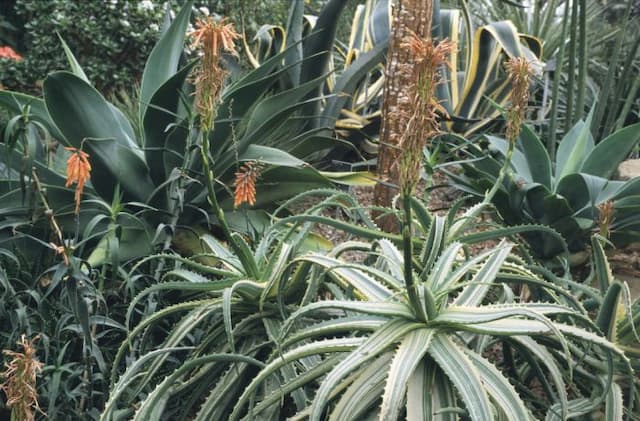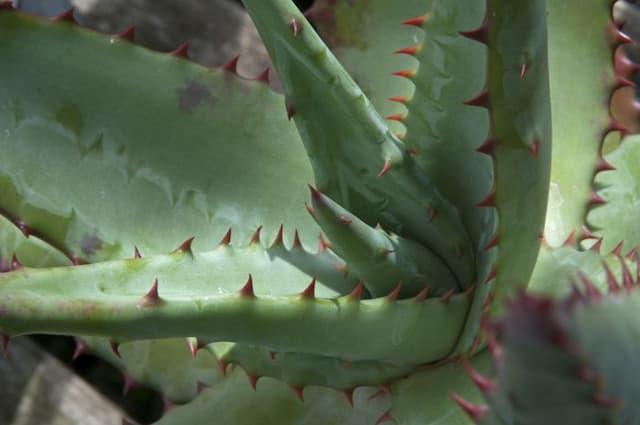Aloe Lizard Lips Aloe 'Lizard Lips'

ABOUT
Aloe 'Lizard Lips' is a succulent with a distinctive and attractive appearance. The plant features thick, fleshy leaves that form a rosette pattern. Each leaf is edged with small, tooth-like projections that give it a somewhat spiny look, resembling the "lips" of a lizard. The leaves are a rich green color and may have splotches or mottled patterns of white or lighter green. These spots become more pronounced under stress, such as intense sunlight or minimal water. During its blooming period, Aloe 'Lizard Lips' sends up a flower spike from the center of its rosette, and the flowers typically have a tubular shape and can come in hues of red or orange, adding to its ornamental appeal. Overall, the thick leaves and distinctive coloring make Aloe 'Lizard Lips' a visually striking plant.
About this plant
 Names
NamesFamily
Asphodelaceae
Synonyms
Lizard Lips Aloe, Aloe 'Lizard Lips'
Common names
Aloe 'Lizard Lips'.
 Toxicity
ToxicityTo humans
The Aloe Vera plant, from which the Aloe 'Lizard Lips' cultivar is derived, contains compounds that can be toxic if ingested. Consumption of Aloe Vera can lead to diarrhea, cramps, dehydration, and can also interfere with the absorption of medications. Eating the leaves of Aloe Vera might lead to abdominal discomfort, diarrhea, or lethargy. It is advisable to refrain from consuming any part of the plant, especially in significant quantities.
To pets
The Aloe Vera plant is toxic to pets. If a pet ingests Aloe Vera, they may exhibit symptoms such as vomiting, diarrhea, lethargy, and in rare cases, tremors. The toxic compounds in Aloe Vera can also cause depression and changes in urine color. To prevent any adverse health consequences, pets should be kept away from this plant, and any ingestion of Aloe Vera by a pet should lead to a consultation with a veterinarian.
 Characteristics
CharacteristicsLife cycle
Perennials
Foliage type
Evergreen
Color of leaves
Green
Flower color
Orange
Height
1-2 feet (30-60 cm)
Spread
1-2 feet (30-60 cm)
Plant type
Succulent
Hardiness zones
9
Native area
Africa
Benefits
 General Benefits
General Benefits- Easy to Grow - Aloe 'Lizard Lips' is a hardy and easy-to-care-for plant that thrives with minimal attention, making it suitable for gardeners of all skill levels.
- Drought Tolerant - Well-adapted to dry conditions, this plant requires little water, which is great for water conservation and areas prone to drought.
- Low Maintenance - It doesn't need frequent fertilizing or pruning, saving time and effort in plant care routines.
- Attractive Appearance - This aloe variety has a unique appearance, with spotted leaves that can add an interesting visual touch to gardens or indoor settings.
- Compact Size - Its small size makes it an excellent choice for growing in containers, on windowsills, or in small garden spaces.
 Medical Properties
Medical Properties- Skin Healing: Aloe 'Lizard Lips', as part of the Aloe genus, contains a gel that can be used topically to soothe minor burns, cuts, and skin irritations.
- Moisturizing: The mucilaginous gel found in Aloe 'Lizard Lips' leaves is known for its hydrating properties and can help in moisturizing dry skin.
- Anti-inflammatory: Components within Aloe 'Lizard Lips' may possess anti-inflammatory qualities that can help reduce topical inflammation when applied to the skin.
 Air-purifying Qualities
Air-purifying QualitiesThis plant is not specifically known for air purifying qualities.
 Other Uses
Other Uses- Art and Craft Material: The leaves of Aloe can be used in art projects as stamps due to their unique texture and shape.
- Decorative Ice Cubes: Freeze pieces of the Aloe plant in ice cube trays for an ornamental touch in beverages for events or special occasions.
- Natural Hair Gel: The gel inside Aloe leaves can be used as a natural hair styling product, giving light hold without harmful chemicals.
- Plant Dye: Aloe leaves can be boiled to produce a natural green dye for fabrics or Easter eggs.
- Culinary Garnish: Although not commonly consumed, thin slices of Aloe can add an interesting visual garnish to culinary dishes.
- Protection Against Erosion: Aloe plants can be used in gardens to help prevent soil erosion due to their root structure.
- Water-wise Garden Feature: Aloe is drought tolerant and can be used in xeriscaping, reducing the need for frequent watering in gardens.
- Education: Aloe plants can be used in educational settings to teach about succulent plant care and reproduction, as they are easy to propagate.
- Photography Subject: With their interesting patterns and textures, Aloe plants make a great subject for practicing macro and close-up photography.
- Personalized Gifts: Small Aloe plants can be potted and given as sustainable, personalized gifts for friends and family.
Interesting Facts
 Feng Shui
Feng ShuiAloe Vera is known for its healing and purifying qualities, so in Feng Shui it is often placed in the wealth area of a home or the health and family area to promote positive energy and to ward off negative influences.
 Zodiac Sign Compitability
Zodiac Sign CompitabilityAloe Vera is not used in astrology practice.
 Plant Symbolism
Plant Symbolism- Healing and Protection: The Aloe vera plant is commonly associated with healing due to its medicinal properties, used for treating cuts, burns, and skin ailments.
- Patient Care: Aloe requires infrequent watering and tolerates neglect, symbolizing the need for patience and persistent care in nurturing relationships.
- Beauty and Skin Care: Known for its beauty benefits, Aloe represents inner and outer beauty, reminding us of the importance of self-care and natural remedies.
- Resilience and Adaptation: As a succulent, Aloe is adept at surviving in harsh environments, symbolizing the ability to adapt and thrive under difficult conditions.
- Good Luck and Positive Energy: Aloe is believed to bring good luck and positive energy into the home, often placed in houses as a talisman against negative influences.
- Purification: The plant is thought to have air-purifying qualities, representing the purification of energies and the promotion of a healthy, harmonious living space.
 Water
WaterAloe 'Lizard Lips', commonly known as Plicatilis, should be watered deeply but infrequently to mimic the natural arid environment where it thrives. Allow the soil to dry out completely before watering again, typically every 2 to 3 weeks. When watering, give enough water so that it runs through the drainage holes; for a small container, this might be approximately 8 to 16 ounces depending on the pot size and environmental conditions. During the winter, reduce watering to once a month or less as the plant enters a dormant period.
 Light
LightAloe 'Lizard Lips' prefers bright, indirect sunlight and flourishes in a sunny windowsill that receives this type of light for most of the day. Direct sunlight can be tolerated but should be limited to avoid scorching the leaves. If indoors, an east or west-facing window is often ideal, as long as the light is not too intense.
 Temperature
TemperatureAloe 'Lizard Lips' does best in temperatures ranging from 60 to 75 degrees Fahrenheit. It can survive minimum temperatures of around 50 degrees Fahrenheit but should not be exposed to frost. The ideal temperature range supports optimal growth and health of the plant.
 Pruning
PruningPruning Aloe 'Lizard Lips' is generally done to remove damaged or dead leaves to maintain the plant's appearance and health. Use clean, sharp scissors or pruning shears and cut close to the base without damaging the main rosette. Pruning is best done in the spring or early summer when the plant is actively growing.
 Cleaning
CleaningAs needed
 Soil
SoilAloe 'Lizard Lips' prefers well-draining soil with a mix of cactus potting soil, coarse sand, and perlite. The pH should be slightly acidic to neutral, around 6.0 to 7.5.
 Repotting
RepottingAloe 'Lizard Lips' should be repotted every two to three years or when it outgrows its container, whichever comes first.
 Humidity & Misting
Humidity & MistingAloe 'Lizard Lips' thrives best in dry conditions and does not require high humidity levels, typical household humidity is adequate.
 Suitable locations
Suitable locationsIndoor
Provide bright, indirect sunlight and well-draining soil.
Outdoor
Needs well-draining soil, full sun to partial shade.
Hardiness zone
9-11 USDA.
 Life cycle
Life cycleThe life of the Aloe 'Lizard Lips', commonly known as Aloe, starts with germination, where the seeds sprout in warm, well-draining soil with adequate moisture. The seedlings develop into juvenile plants with small rosettes of fleshy, spiky leaves characteristic of young aloe plants. As they mature, these rosettes widen, and the plant's leaves thicken, sometimes displaying marginal teeth and colorful markings, often in response to sunlight exposure. The Aloe 'Lizard Lips' reaches maturity in a few years and produces a flower spike, or inflorescence, with tubular yellow to orange flowers that attract pollinators such as bees and hummingbirds. After pollination, the plant may produce seed pods containing seeds that can be dispersed to grow new plants. The parent plant continues to grow and can produce offsets or "pups" around its base that can be separated to propagate new individual plants.
 Propogation
PropogationPropogation time
Spring-Summer
Aloe 'Lizard Lips' can be propagated easily through the division of offsets, which are small clones that the parent plant produces at its base. The best time to separate these offsets for propagation is during the spring or early summer when the plant is actively growing. When an offset has formed several leaves and appears to have its own roots, it should be gently removed from the parent plant with a clean, sharp instrument. Taking care to keep the roots intact as much as possible, the offset can then be placed into a pot filled with a well-draining cactus or succulent potting mix. It's crucial to let the offset sit for one or two days to allow the cut end to callus over before planting, which can help prevent rot. Once potted, the offset should be watered sparingly to encourage root growth, keeping the soil lightly moist but not soggy.









